
views
- Rinse and clean the wound with saline solution to disinfect it. Then wash your hands with soap and water, and put on nitrile gloves.
- Apply a layer of petroleum jelly in a circle around the wound to isolate the silver nitrate once applied.
- Apply the silver nitrate according to the instructions on the packaging, typically with a clean cotton swab. Rinse the wound with saline and wrap it in clean gauze.
Applying Silver Nitrate to a Wound
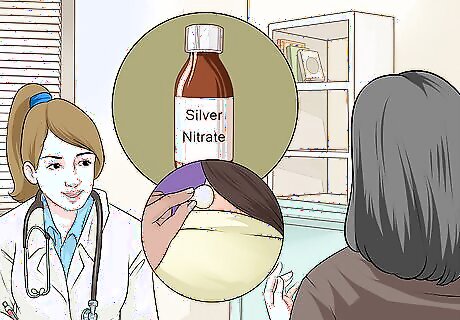
Buy a silver nitrate solution or stick. To treat small wounds that won't heal properly, silver nitrate is the safest and most common form of cauterization. Purchase silver nitrate in liquid or stick form from a pharmacy or online. Before purchasing, consult a doctor or pharmacist for advice on what strength of silver nitrate to use. Silver nitrate will remove dead skin from the wound area, allowing it to heal properly. Silver nitrate solution is available over the counter in concentrations ranging from 0.5% to 50%. Silver nitrate sticks have the strongest concentration at 75%, and should only be applied to the specific area to be treated.

Clean your hands and apply gloves. It is important to minimize the spread of germs as much as possible when dealing with open wounds. Wet your hands, apply an antibacterial soap, and scrub them for at least 20 seconds before rinsing them. Dry your hands on a clean towel and put on latex or nitrile gloves to reduce the chance of infection.

Clean the wound. Douse a gauze pad with a saline solution. Start at the middle of the wound and dab outwards, reaching to about 1 inch (2.5 cm) beyond the wound area. Clean away any liquid or debris coming out of the wound, then let it air dry. Cleaning a wound from the outside toward the middle may spread bacteria into it. You can make your own saline solution or purchase it from a pharmacy.

Use petroleum jelly to confine the wound area. After you clean the wound, remove your gloves, wash your hands, and put on new gloves. Silver nitrate treatment is a mild form of cauterization, but it will still harm healthy skin if it comes into contact with it. Apply petroleum jelly to the area of skin surrounding your wound with a clean gloved fingertip or gauze pad. Be sure that all surrounding skin is protected so that you can apply silver nitrate without worry.

Apply silver nitrate as directed. Always follow a doctor's or pharmacist's instructions for applying silver nitrate to your wound, which will vary depending on how bad your wound is and the type of application that you use. Silver nitrate sticks should be dipped in distilled water to activate them before use, while a silver nitrate solution should be applied to a cotton ball or gauze pad. When applying silver nitrate directly to the tissue, gently rub and rotate the tip of the applicator along the tissue. As a general rule, 2 minutes of contact time on the wound should be enough to treat it. Avoiding letting silver nitrate come in contact with your clothing or any other surfaces as it is caustic.
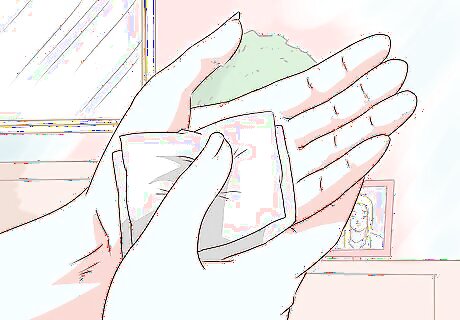
Clean the treated area. After you apply the treatment, use a saline-soaked gauze pad to dab the wound area. Be gentle to avoid rubbing or scratching the sensitive tissue. Pat it dry with a clean gauze pad.

Dress the wound. Place a clean piece of gauze that is slightly larger than your wound over the wound. Secure the edges of the gauze to your surrounding skin with medical tape. If you wish, apply a clean bandage around the gauze for extra protection.
Using Fire and Metal
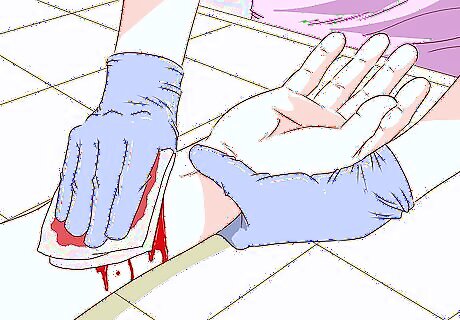
Assess your wound. Emergency cauterization with heated metal should only be done when there are no other options for treating a serious wound. Try putting pressure on the wound and applying a tourniquet to stop the bleeding. If neither of these options help to slow down the bleeding, opt to cauterize the wound before you lose too much blood. Note that cauterization is an incredibly painful procedure and should only be considered in a life or death scenario. Do not attempt cauterization if you have a way to call for medical assistance.

Wash your hands. Wet your hands and lather them with an antibacterial soap for at least 20 seconds. Rinse your hands well and dry them on a clean towel. If you have access to sterile latex gloves, put them on. If you can't wash your hands, use an antibacterial hand sanitizer to disinfect your hands if possible.

Find a metal cauterizing tool. Find a piece of metal that is sturdy enough to withhold intense heat without becoming brittle. The item should be small enough that it doesn't exceed the size of the wound by much. A kitchen knife is an ideal choice since it has a handle, which will make it easy to heat over a flame. A pair of metal scissors could also be a good cauterizing tool.

Sterilize the knife. Wipe down the knife with a disinfectant-soaked cloth to remove germs before using it. Rubbing alcohol and iodine are ideal choices. If you do not have a clean cloth, simply dip your knife in the disinfectant solution and stir it around for 10 seconds. Note that the fire will also help to disinfect the surface of the knife.
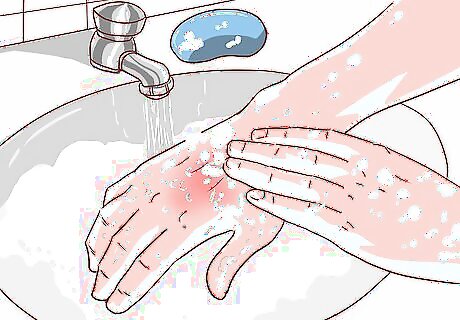
Disinfect your wound area, if possible. If your wound is bleeding enough to warrant cauterization, it may be difficult to disinfect. A shallow wound can be cleaned with soap and water or saline solution. If the wound is too deep, dab the area around it with a clean cloth, cotton ball, or piece of gauze doused with rubbing alcohol or iodine.

Find a source of fire. Examine your surroundings to see if you have access to an open flame. You will need to have this flame burning for several minutes to adequately prepare your knife for cauterizing. A bonfire or stove burner are good options. If necessary, start a fire that you can control and put out afterwards (e.g. in a metal garbage pail).
Heat the metal until it is almost red. Place your knife or tool over the open flame to heat it. Let it heat for as long as it takes to reach a dull red glow. Do not continue heating past the point that you see a hint of red. Be sure and hold the knife or tool with a towel, cloth, or pot holder since the heat will make it's way down the handle.
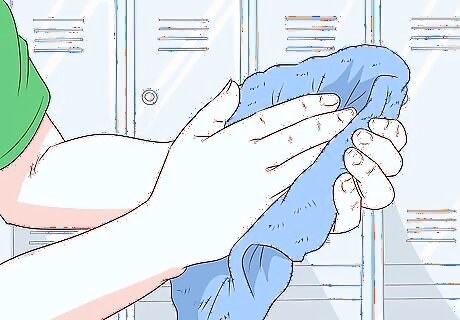
Find something to bite down on. Cauterization will be extremely painful and jarring, so it is best to prepare yourself. Find something clean to bite down on like a rolled up washcloth. Avoid biting down on anything that you might break with your teeth, like a pencil or popsicle stick.
Apply the knife to the wound area in small bursts. Avoid leaving the heated surface of the knife on your skin for too long as it will burn into your healthy skin tissue. Apply the knife to the wound surface in short bursts of 1 to 2 seconds each. As soon as you see no more bleeding, assume that the wound is closed and stop cauterizing it. Cauterizing causes the coagulation of blood, which in turn stops bleeding. Cauterization should be done quickly, so there should be no need to re-heat the knife during the process.
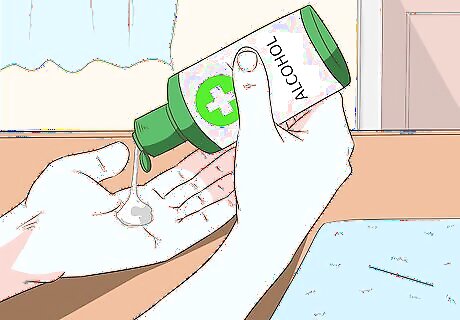
Clean the closed wound. Infection is a great risk of cauterization as second and third-degree burns can leave the body susceptible to germs. After sealing the wound, douse it with rubbing alcohol if you have it. Keep in mind that this should only be done in emergency situations. Rubbing alcohol is not generally used to clean wounds and can actually slow the healing process. However, it can be used to clean a wound in this scenario.

See a doctor as soon as possible. While cauterization may be the best option in an emergency situation, you should seek medical attention as soon as possible. Go to an emergency room or walk-in clinic as soon as you can to have your wound inspected and treated properly. A doctor will be able to prescribe you antibiotics if you are at risk of an infection.










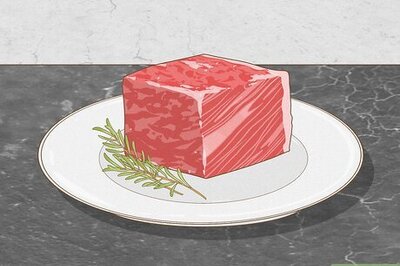









Comments
0 comment